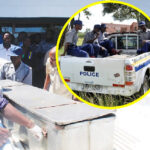Harare – The fight against HIV/AIDS has taken a monumental leap forward with the announcement of a twice-yearly injection offering 100% protection against the virus. The news, which has sent ripples of excitement through the global health community, comes from a groundbreaking study published in the prestigious New England Journal of Medicine.
The study, conducted in South Africa and Uganda, involved over 5,000 young women and girls. Those who received the injections, known as lenacapavir, remained completely free from HIV infection. In contrast, a control group given daily prevention pills saw a 2% infection rate.
“To see this level of protection is stunning,” declared Salim Abdool Karim, director of an AIDS research centre in Durban, South Africa, who was not involved in the research. “This is a game changer.”
The injections, developed by US drugmaker Gilead and marketed as Sunlenca, are currently approved for treating HIV in several countries, including the US, Canada, Europe, and others. However, this study marks a significant shift in its application, highlighting its potential as a powerful preventative tool.
While the study focused on women, Gilead is awaiting results of trials in men before seeking approval to use Sunlenca for HIV prevention in all genders. The company has expressed its eagerness to pursue this avenue, recognizing the immense potential of this groundbreaking medication.
The study’s findings have sent a wave of optimism through the global health community, particularly in Africa, where HIV/AIDS remains a major public health concern. The continent bears a heavy burden of the epidemic, with 46% of new infections globally in 2022 occurring in women and girls.
“The prospect of a twice-a-year shot is ‘quite revolutionary news’ for our patients,” said Thandeka Nkosi, who helped run the Gilead research at the Desmond Tutu Health Foundation in Masiphumelele, South Africa. “It gives participants a choice and it just eliminates the whole stigma around taking pills” to prevent HIV.
The potential of Sunlenca to transform the fight against HIV/AIDS is undeniable. However, concerns remain regarding its accessibility and affordability, especially in low-income countries. While Gilead has pledged to pursue a “voluntary licensing programme,” allowing a select number of generic producers to manufacture the drug, critics argue that this approach may not be sufficient to ensure widespread access.
“Gilead has a tool that could change the trajectory of the HIV epidemic,” said Winnie Byanyima, executive director of the Geneva-based U.N. AIDS agency. “We urge Gilead to share Sunlenca’s patent with a U.N.-backed program that negotiates broad contracts allowing generic drugmakers to make cheap versions of drugs for poorer countries worldwide.”
The cost of Sunlenca as an HIV treatment in the US currently exceeds $40,000 per year, although individual costs vary. Dr. Helen Bygrave of Doctors Without Borders, in a statement, emphasized the importance of making the injections affordable for all countries, stating that they could “reverse the epidemic if it is made available in the countries with the highest rate of new infections.”
Gilead, in a statement last month, acknowledged the importance of affordability and stated that it was too early to determine the cost of Sunlenca for prevention in poorer countries. However, the company has initiated discussions with generic manufacturers, recognizing the critical need for affordable access.
The news of Sunlenca’s effectiveness has been met with cautious optimism, with experts highlighting the importance of ensuring equitable access to this life-saving medication. The potential for Sunlenca to significantly reduce HIV infections, particularly among women and girls, is undeniable. However, its success hinges on the commitment of pharmaceutical companies, governments, and international organizations to ensure its affordability and availability to those who need it most.












